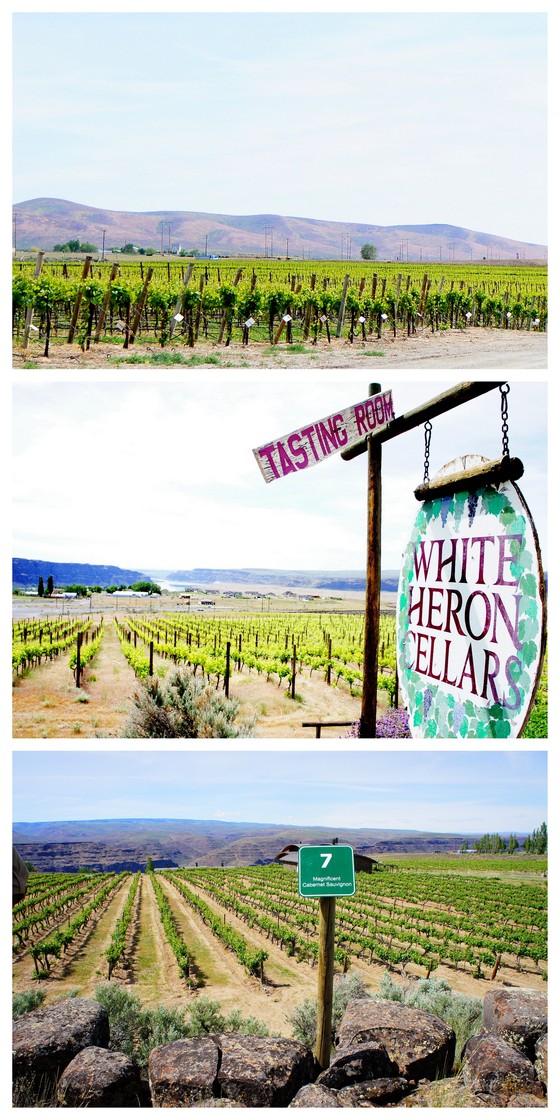Below, three views within Washington State's newest viticultural area, the Ancient Lakes AVA. Top: Jones of Washington's Two-Gun Vineyard on Babcock Ridge, the northenmost part of what's known as the Quincy Basin. Center: White Heron's south-facing vineyards at Trinidad, overlooking the Crescent Bar resort on the Columbia River. That rocky cliff at the left of the middle photo is the site of Cave B's red-wine vineyard, bottom.
In wine, if you're a grape, you are first and foremost the continuation of your parent's variety. A chardonnay plant produces chardonnay grapes, not merlot. But beyond that, you are where you grow. Sure, the production team can fiddle with your juice, but they can't fool Mother Nature: the spot where you were planted, whose vine gave birth to your cluster, determines who you are and what will become of you.
If you're one of those people who wants to know things like "Where did you grow up?" and "Where did you go to college?" you'll understand why this geographical precision is so important. If you don't care about lineage in these so-called egalitarian times, stop reading and drink a glass of Franzia; the rest of this piece won't mean a thing to you. So let's get organized, shall we?
 The Columbia, at 1,214 miles in length, ranks fourth among North America's great rivers, behind the Mississippi-Missouri, the Saint Lawrence, and the Mackenzie. It drains a basin that extends from the Rockies to the Pacific Ocean; it has twice the flow of the Nile, ten times as much as the Colorado.
The Columbia, at 1,214 miles in length, ranks fourth among North America's great rivers, behind the Mississippi-Missouri, the Saint Lawrence, and the Mackenzie. It drains a basin that extends from the Rockies to the Pacific Ocean; it has twice the flow of the Nile, ten times as much as the Colorado.
Mind you, this is not at all like the Grand Canyon. The desert of the southwest is truly ancient; its photogenic canyons were not carved in a single cataclysm but eroded over time. The Colorado's red stone is soft, friable, unlike the Columbia's unforgiving black basalt.
The Columbia Valley was named an American Viticultural Area in 1984, encompassing 200,000 acres of eastern Washington and a few more in Oregon. Almost all Washington's AVAs before and since, from the Yakima Valley in 1983 to Ancient Lakes in 2012, are smaller zones within the Columbia Valley.
Think of the Columbia today as a broad, cursive "S" starting up in Canada, descending roughly-roughly to Wenatchee and turning southeast to the Tri Cities. Then it becomes a long-tailed curve that first loops south, then west, as the Columbia River Gorge forms the border with Oregon. This makes sense if you consider the tumultuous geology of the last Ice Age, when vast torrents of water from Lake Missoula came crashing toward the Pacific Ocean, carving through the basalt with unimaginable fury. Today the river still drops twice as far as the Mississippi in half the distance, but its enormous power has been harnessed, midway, by the nation's biggest hydroelectric project, the Grand Coulee Dam. The electricity generated by Grand Coulee, and companion dams like Bonneville, provides the Northwest with the nation's cheapest electricity and turned its economy into a high-tech, high-wage paradise. It's not an unmixed blessing, however, as Blaine Harden explains in his richly detailed book, A River Lost.
In any event, the mighty Columbia, hemmed in by towering basalt cliffs, is now as placid as a fishing pond. (Only the topsoil is windblown volcanic loess, dry with very little organic matter; the lack of nitrogen makes for a smaller vineyard canopy and results in grapes with more intense flavor.) At the "island" resort of Crescent Bar it meets a recreation area complete with boat ramps, vacation homes and nine-hole golf course. This is the northwest corner of the new Ancient Lakes AVA and the site of Cameron Fries's White Heron vineyards. Fries, who trained in Switzerland, planted grapes here three decades ago and was the first winemaker for Champs de Brionne; he remains, with Vince Bryan, the driving force behind AVA. Bryan's son-in-law Freddy Arredondo is the highly capable wine maker at the family's Cave B Estate Vineyard, which overlooks the river from a 900-foot basalt cliff.
The northern boundary of the AVA extends toward Quincy, where Jones of Washington has planted an enormous vineyard on the gentle slopes of Babcock Ridge. The other big player in the AVA are the Milbrandt brothers, Butch and Jerry, whose Ancient Lakes grapes are grown for Washington's best riesling, the Chateau Ste. Michelle - Ernest Loosen collaboration called Eroica. Andy Perdue and Eric Degerman, who've been chronicling the region's wine production for a couple of decades, call it "the most remarkable wine in the Northwest."
Nuzzled right up to the Cascades, the Ancient Lakes climate is one of the state's driest. The AVA covers 160,000 acres, though only one percent of that is planted. The cooler Ancient Lakes foothills include the Two Gun vineyard. White Heron is in what's called the Benches, a warmer site, suitable for reds. Vineyards planted along the coulees that border the Columbia, like Cave B's, and on the ridges alongside the AVA's "pothole" lakes are ideal for white varieties like chardonnay and sauvignon blanc that thrive in cooler sites.
Cameron Fries and Vince Bryan have known for years that the over-arching Columbia Valley designation didn't do justice to their wines. Over the years, many of the state's most competent growers (and best wine journalists) have come around to that thinking as well. The new AVA is their reward. Now you can be a savvy consumer of Washington wine by looking for bottles with "Ancient Lakes" on the label. Obsessive searching will be well-rewarded.

Leave a comment